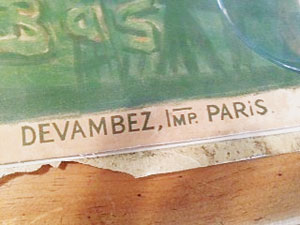 CS sends me an image of a French advertising poster originally drawn by the under-appreciated Symbolist artist Lucien Levy-Dhurmer. CS’s family apocrypha claims this dates to the early 1900’s. He surmises the artist used this original drawing to make lithographs. If true, CS would be $20k richer right now. And if true, the writing on the bottom of the image would NOT say Devambez, Imp. Paris. Because the latter means this image was printed at the print shop (a famous one, albeit) in Paris, the Maison Devambez.
CS sends me an image of a French advertising poster originally drawn by the under-appreciated Symbolist artist Lucien Levy-Dhurmer. CS’s family apocrypha claims this dates to the early 1900’s. He surmises the artist used this original drawing to make lithographs. If true, CS would be $20k richer right now. And if true, the writing on the bottom of the image would NOT say Devambez, Imp. Paris. Because the latter means this image was printed at the print shop (a famous one, albeit) in Paris, the Maison Devambez.
The story behind the lithograph sounds fascinating despite it NOT achieving the worth of $20k. CS mentions it has a chalky feel to it. This gives us clues to the WHY and HOW of its production.
CS guesses the drawing is original because he recalls the artist, Lucien Levy-Dhurmer, became famous for his work in oil pastel. That media results in a kind of chalky feel which breaks down with rough handling.
Partially correct
CS, you possess a chalk-manner lithograph. The artist produces this in conjunction with his printer. He uses a wax crayon to draw an image on to a piece of limestone. We call it a planographic technique, meaning the drawing is done on a plane, in this case a limestone tablet which remains flat. The artist prepares the printing surface by laying the image on a greasy substance slathered on the stone that will hold ink and leaves the non-image areas of the plate receptive to water, which repels ink. Thus some of CS’s lithograph has deep tonal differences. The depth of the blue color, for example, varies greatly because of a greater amount of blue ink in the deeper tones of blue.
Think about it for a while and you will realize some older lithographs may “dust” away, and feel chalky.
When he first conceived the idea, an artist painted a chalk manner lithograph on extremely rough limestone. So a line is not really a line when ink is spread on it but a series of dots, producing a chalky stippled appearance. Think of dragging a candle on a rough brick wall and you will get the idea.
Time to discuss what the poster means
Notice a beleaguered young soldier supporting an old and tired but noble looking bearded man. The artist struck this image in 1920, which tells us a lot about the symbolism. France’s efforts in the First World War left her sorely distressed. Germany banged on her gates at this time, yet the light shone at the end of the tunnel because the allies received a burst of strength from the Americans who joined them a few years before in 1917.
The young soldier represents the bighearted patriotic young soldier on the front, tired from six years of war. The old man represnts the tired France, dignified still with his long beard. Help France! – this poster seems to plead.
How did this poster aim to help dear old France, so sad and so devastated in 1920?
By encouraging the French citizenry to loan the government money, which the government promised to repay at about a 5% annuity. You see, the French had a unique system of waging war, not by taxation as much as by public support. Many great French artists at this time wrung French heartstrings with posters of total patriotism.
The graphics on this poster proclaim “Subscribe! To the Nation’s Borrowing Needs! To the Bank of Paris!” Any French citizen recognized by the way the old man pointed, that prosperity (industry) lies ahead, if all Frenchmen contributed. The propaganda campaign to raise money for France via her fine artists doing patriotic work became remarkable, as much for the money raised as for the fine and wonderful posters produced.
A little bit about the artist who made this poster
Lucien Levy-Dhurmer, one of the Circle of Symbolist Artists in the late 19th to early 20th centuries, fronted, some believe, by the greatest of them all, the teacher and painter Gustave Moreau. Symbolism is a sexier and subtler, more dreamlike, more nude, subset of Surrealism, and is sister in the works of the English Pre-Raphaelite painters with the half conscious gorgeous androgynous female models. Levy- Dhurmer became renowned in his age for his dreamy naked melancholy gorgeous fulltressed women in his dreamy oil pastel Symbolist style. Paris birthed modern art at this time, but he went another direction, a direction the public and the academy LOVED. He took Societe Nationale des Beaux Arts by storm in 1906 onward.
Levy-Dhurmer became known as a huge talent in his age
He Wrote poetry, painted, designed ceramics, and worked for rich friends in interior design. Possibly because of his talented creativity, his interior design – for his era – focused on a total concept of integration, in furniture, art, surfaces, ceramics, rugs and finery in general.
CS’s wonderful poster, which for its age and the fact that they displayed it unframed on the streets of Paris during wartime, remains in GOOD shape. The value is about $1,500-2,000. I love it myself as the height of illustration art used for a political purpose.